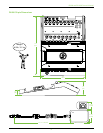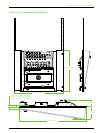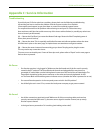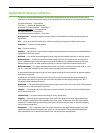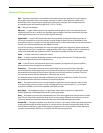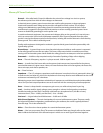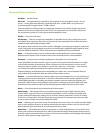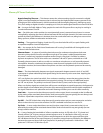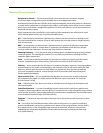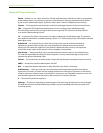
DL806 and DL1608 Owner’s Manual
41
Glossary Of Terms Continued...
Mic Amp
— See Mic Preamp.
Mic Level
— The typical level of a signal from a microphone. A mic level signal (usually – but not
always – coming from a microphone) is generally lower than –30 dBu. With a very quiet source
[a pin dropping?] the signal may be –70 dBu or lower.
Some microphones, notably vintage or vintage-style condenser mics, deliver a higher signal level
than this for the same sound pressure level. A “hot” mic output level isn’t necessarily a measure of
the microphone’s quality; it’s just an option that the designer(s) chose.
Mic Pre
— Short for Mic Preamp.
Mic Preamp
— Short for microphone preamplier. An amplier whose job is to bring the very low
microphone level signal up to line level, or in the case of a mic preamp built into a mixer, the mixer’s
internal operating level [approximately 0 dBu].
Mic preamps often have their own volume control, called gain, to properly set the gain for a particular
source. Setting the mic preamp gain correctly is an essential step in establishing good signal-to-noise
ratio and sucient headroom. The DL Series mixers are outtted with Onyx mic preamps.
Mixer
— An electronic device used to combine various audio signals into a common output.
Dierent from a blender, which combines various fruits and alcohol into a common libation.
Monaural
— Long for mono. Literally, pertaining to or having the use of only one ear.
In the audio eld, monaural describes a signal or system which carries audio information on a single
channel with the intent of reproducing it from a single source. One microphone is a mono source;
many microphones mixed to one channel is a mono mix; a stereo (or – to be picky – a two-channel)
mix of many microphones panned left and right is a stereo mix of mono sources.
Monaural listening, and therefore mono compatibility of a stereo mix, is more important than you
might realize. Most people hear television audio and clock radios in mono.
Monitor
— In sound reinforcement, monitor speakers [or monitor headphones or in-ear monitors] are
used by performers to hear themselves. In the video and broadcast world, monitor speakers are often
called foldback speakers. In recording, the monitors speakers are those used by the engineer and
production sta to listen to the recording as it progresses. In zoology, the monitor lizard is the lizard
that observes the production sta as the recording progresses. Keep the lizard out of the mixer.
Mono
— Short for monaural (and mononucleosis for that matter).
Mute Groups
— Mute groups allow you to quickly mute (and unmute) multiple channels and/or
outputs with a single tap. There are a multitude of possibilities in which to assign and enable mute
groups: productions featuring a rotating cast of musicians, theater productions, a house of worship
and more. It is also great for muting all inputs during song breaks or in-between sets. You may create
as many as four separate mute groups with Master Fader.
Noise
— Whatever you don’t want to hear. This could be hum, buzz or hiss; or it could be crosstalk, digital
hash, or your neighbor’s stereo; or it could be white noise, pink noise or brown noise. It’s also how your
parents describe your band. After all, it’s what they don’t want to hear.
Noise Floor
— The residual level of noise in any system. In a well-designed mixer (such as the DL Series
mixers), the noise oor will be a quiet hiss, which is the thermal noise generated by electrons bouncing
around in resistors and semiconductor junctions. The lower the noise oor and the higher the headroom,
the more usable dynamic range a system has.



